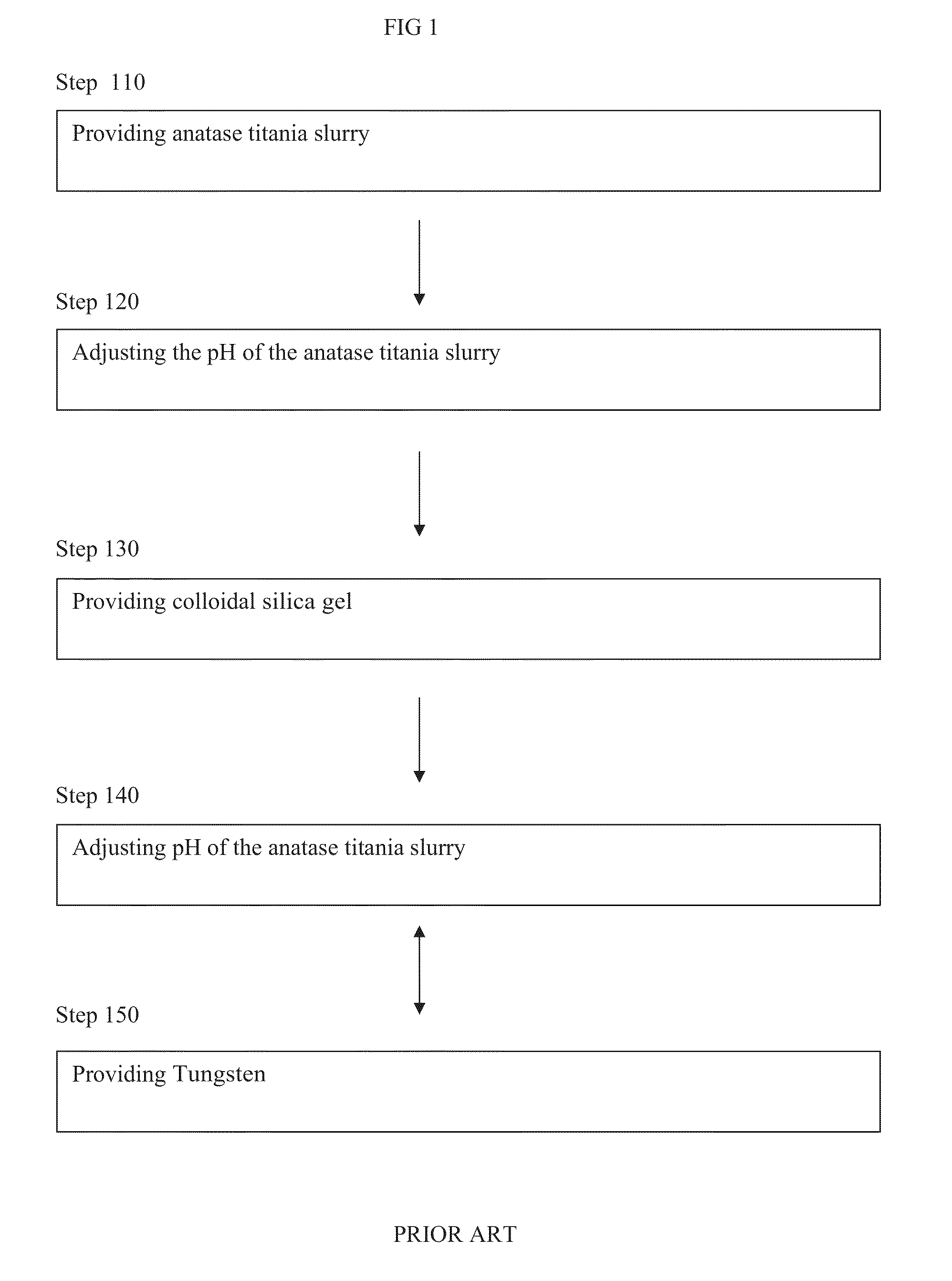Catalyst support materials, catalysts, methods of making them and uses thereof
a technology of catalyst support materials and catalyst compositions, applied in physical/chemical process catalysts, metal/metal-oxide/metal-hydroxide catalysts, separation processes, etc., can solve the problems of limited molybdenum-containing catalyst systems, price and availability limitations of tungsten-containing catalysts, and one or more limitations
- Summary
- Abstract
- Description
- Claims
- Application Information
AI Technical Summary
Benefits of technology
Problems solved by technology
Method used
Image
Examples
example 1
[0118]An embodiment of the presently disclosed and / or claimed inventive concept(s) was prepared in the following manner. A 370.7 g sample of anatase titanium hydrolysate slurry (26.3% solids), produced via the sulfate process (Trade name—GI from Millennium Inorganic Chemicals), is heated to 60° C. via a temperature controlled hot plate, and the temperature is maintained at 60° C. throughout the preparation. The pH is adjusted to 4 with dilute ammonium hydroxide. A dilute solution (1 w % SiO2) of sodium silicate is prepared by adding 1.7 g of Inobond Na-401 sodium silicate (29.4 w % as SiO2) to 48.4 g of deionized water. A 20 g portion (as received basis) of strong acid ion-exchange resin Dowex™ 650C H-form is weighed out and placed in a buret column. (Dowex™ 650C H-form ion exchacge resin was used in the examples below and is available by The Dow Chemical Company, US) The dilute silicate solution is added through the column containing the ion exchange resin to the slurry at a rate o...
example 2
[0121]In a second embodiment of the method, the order of addition of silica and the molybdenum and phosphorus solutions were reversed such that the molybdenum and phosphorus solution is added through the ion exchange column prior to the silica solution. Vanadia is added as described in Example 1.
example 3a
[0124]A 183.3 g sample of anatase titanium hydrolysate slurry (26.6% solids) is heated to 60° C. via a temperature controlled hot plate and the temperature is maintained throughout the preparation. A molybdenum solution is prepared by dissolving 1.84 g of ammonium heptamolybdate in 20 ml water. This solution is added to the slurry. After the addition is complete, the pH of the mixture is adjusted to 5 with a dilute ammonium hydroxide solution and allowed to react for 10 min. A dilute solution (1 w % SiO2) of sodium silicate is prepared by adding 0.85 g of Inobond Na-4011 sodium silicate (29.4 w % as SiO2) to 24.1 g of deionized water. A 10 g portion (as received basis) of strong acid ion-exchange resin (Dowex™ 650C H-form) is weighed out and placed in a buret column. The dilute silicate solution is added through the column containing the ion exchange resin to the slurry at a rate of 10 ml / mm. The column is then rinsed with 10 ml of deionized water at a feed rate of 10 ml / min. The pH...
PUM
| Property | Measurement | Unit |
|---|---|---|
| volume weighted median size | aaaaa | aaaaa |
| diameter | aaaaa | aaaaa |
| molar ratio | aaaaa | aaaaa |
Abstract
Description
Claims
Application Information
 Login to View More
Login to View More - R&D
- Intellectual Property
- Life Sciences
- Materials
- Tech Scout
- Unparalleled Data Quality
- Higher Quality Content
- 60% Fewer Hallucinations
Browse by: Latest US Patents, China's latest patents, Technical Efficacy Thesaurus, Application Domain, Technology Topic, Popular Technical Reports.
© 2025 PatSnap. All rights reserved.Legal|Privacy policy|Modern Slavery Act Transparency Statement|Sitemap|About US| Contact US: help@patsnap.com



